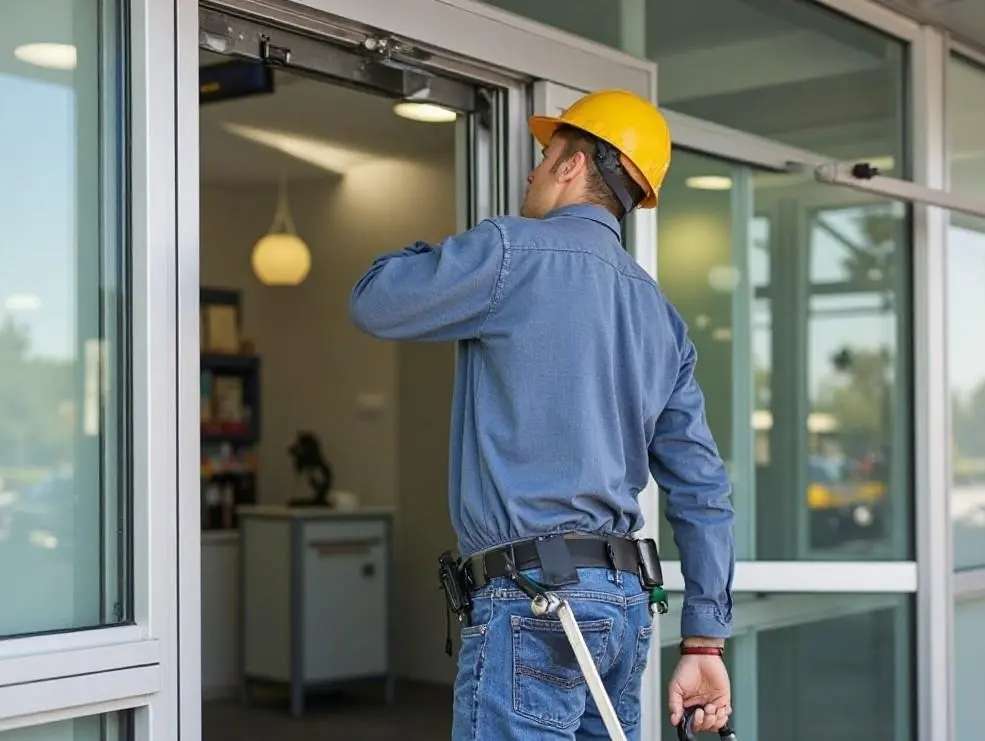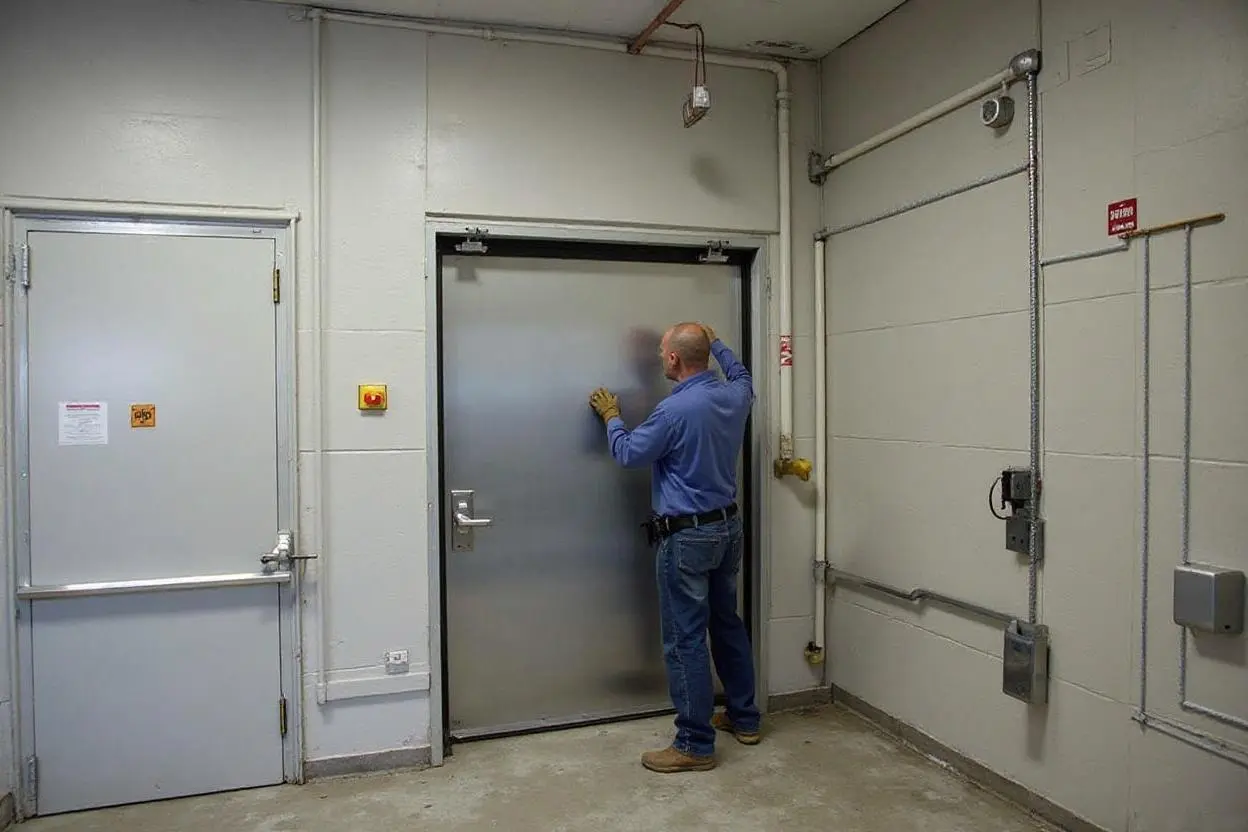What Is the Life Expectancy of an Automatic Sliding Door? Factors, Averages, and How to Extend It
Automatic sliding doors work hard in Buffalo, NY. They face lake-effect winters, slush and salt, summer humidity, and constant foot traffic from early morning to late night. With steady use and the right automatic door maintenance, most commercial sliding doors last 10 to 15 years. Some systems run past 20 years, while neglected or misapplied doors can struggle after 5 to 7.
A-24 Hour Door National Inc: automatic sliding doors repair BuffaloThe range depends on usage, environment, parts quality, and how fast a service team responds when performance changes. Here is a clear look at life expectancy by scenario, what shortens or extends it, and how a Buffalo facility can get more years out of every operator, sensor, and roller.
Typical lifespan by use case
A retail entry on Elmwood Avenue that cycles 1,500 to 2,500 times per day has a different outlook than a medical clinic that sees half that volume. Heavy-use doors tend to need roller replacements in year 3 to 5, safety sensor updates around year 5 to 8, and operator overhauls in year 8 to 12. Light-to-moderate use doors may push those timelines out several years.

Manufacturers rate operators in cycles. A common rating is 1 million to 3 million cycles before major service. In practice, a supermarket entry can hit 1 million cycles in two to three years. A professional office may take eight to ten years to reach that same count. Cycle counts guide planning, but climate, impact events, and cleaning habits matter just as much.
Buffalo climate and why it matters
Cold snaps thicken lubricants and stress plastic parts. Salt and grit ride in on shoes and hang up in bottom tracks. Wind gusts load the belt and motor. Ice can form along the sill and force the door to drag during first openings. These small frictions add daily wear.
A simple example shows the effect: a sliding door in North Buffalo that received quarterly track cleaning and weatherstrip checks kept its original rollers for nine years. A similar door a mile away, with no scheduled service and heavy salt carry-in, needed rollers and a belt in year four. The parts were fine; the grit acted like sandpaper.
Where doors usually fail first
Failures cluster around a few parts. Rollers flatten or pit. Belts stretch or fray. Guide shoes wear. Safety sensors drift out of alignment and miss detection zones. Presence sensors lose range. Control boards fail less often, but power surges during storms can shorten their life.
Glass and framing last a long time unless struck by carts or freight. Most life-cycle cost sits in moving hardware and electronics, which is why automatic door maintenance targets those items before they fail.
How long each component tends to last
- Rollers and guides: 3 to 7 years in heavy use; 6 to 12 in moderate use, depending on track cleanliness.
- Belt and pulley set: 5 to 10 years; earlier if doors are oversized or constantly fighting wind.
- Safety and presence sensors: 5 to 8 years before replacement or re-aiming; technology upgrades often improve reliability and ADA compliance.
- Operator motor and gearbox: 8 to 15 years, tied to cycles and load.
- Control board: 8 to 12 years; surge protection and clean power help.
These are ranges, not promises. A well-set operator with balanced panels and clean tracks often beats the average.
Signs your sliding door is losing years
Doors age in ways that show up in sound, speed, and force. A healthy door opens smoothly, at a steady speed, and closes without a thud. Watch for longer opening times on cold mornings, squeaks on approach, panels that shudder near full open, or safety beams that nuisance trip. Resist the urge to “turn up the force” to mask drag. That stresses the motor and increases risk.

An uptick in after-hours alarms can trace back to a drifting sensor or belt slip. The fix costs less when caught early. Waiting turns a 30-minute adjustment into a multi-part replacement.
Maintenance that adds years, not months
A repeatable program beats sporadic repair calls. Facilities in Buffalo benefit from seasonal attention: pre-winter service to prepare for salt and cold, and a spring reset to clean tracks and reset sensors after harsh weather.
Automatic door maintenance best practices include inspection of all safety devices, cleaning and vacuuming of bottom tracks, checking roller wear and door balance, measuring opening and closing speeds against spec, verifying presence sensor zones for ANSI compliance, tightening belt tension, checking door-to-floor gaps and weatherstrips, and logging cycle counts if available. A-24 Hour Door National Inc. uses a checklist that ties each task to performance metrics, so small changes are visible across visits.
How service frequency aligns with use
A busy grocery in Cheektowaga benefits from monthly quick checks and a deeper quarterly service. An outpatient clinic on Delaware Avenue often runs well on quarterly service and a winter readiness visit. Low-volume professional offices may be fine with two visits per year, plus rapid response when symptoms show up.
The cost curve favors prevention. It is common to see a 20 to 30 percent reduction in unplanned downtime after the first year of consistent service, measured by fewer after-hours calls and fewer large parts orders.
Parts quality and vendor choices
Not all replacement parts age the same. OEM-grade rollers, belts, and sensors hold calibration longer than bargain substitutes. Mixing brands can work if done by a tech who knows the interface and compliance requirements, but random substitutions create future diagnostic headaches.
Safety and compliance matter along with lifespan. ANSI A156.10 and A156.38 tests are hard to meet with mismatched sensors. Cutting corners can expose the business to liability and shorten component life due to poor alignment.
Retrofit vs. replace: making the call
At year 10 to 12, many facilities face a choice: replace the operator and sensors or keep repairing. The decision hinges on frequency of breakdowns, availability of parts, energy performance, and ADA and ANSI compliance.
If a door requires three or more significant repairs in a year, replacement of the operator package often costs less over the next five years than continued piecemeal fixes. Newer operators reduce energy loss with better sealing and smoother motion, and updated sensors catch more approach paths, reducing false openings during wind gusts off Lake Erie.
Real numbers from the field
A downtown Buffalo pharmacy replaced rollers, belt, and presence sensors at year eight for roughly the cost of a single day of lost trade. The operator then ran another seven years before a full replacement. That mid-life refresh added about 40 percent to the operator’s lifespan.
A hospital entry near the medical campus ran twin sliding doors to 4 million cycles by staging monthly light service and quarterly deep service. Roller changes at year five and nine, plus one control board after a lightning event, kept uptime above 99 percent.
What staff can do day to day
The maintenance team does not need to wrench on the door to help it last. A daily wipe of the bottom track during winter goes farther than most people think. Keep salt and grit out. Report new noises or slower motion right away. Do not prop sliding doors open with wedges or bins. That strains the motor and ruins weatherstrips.
If sensors seem over-sensitive or under-sensitive, resist tape fixes. Call for a reset. Tape blocks create blind spots and liability, and they tend to slide, causing inconsistent behavior.
Energy and comfort payoffs in Buffalo
A smooth, balanced sliding door that closes promptly saves heat in winter. A one-second reduction in closing time across thousands of cycles can make a measurable difference in vestibule temperatures. Less draft means fewer complaints at reception and lower runtime for heaters near the entry. The same logic applies in summer with conditioned air.
How A-24 Hour Door National Inc. extends door life in Buffalo, NY
Local conditions call for local judgment. The team adjusts sensor zones to reduce false opens from drifting snow and blowing leaves. It sets belt tension with room for thermal contraction, so cold mornings do not trip errors. It stocks common rollers, belts, and sensors on the truck, which shortens downtime during busy retail hours.
Service plans are simple: two, four, or twelve visits per year, matched to traffic counts and building use. Each visit includes a written report with readings for opening speed, closing force, and safety response, so facilities can see trends, not just invoices.
Quick checklist for longer life
- Keep bottom tracks clean, especially during salt season.
- Schedule seasonal service: pre-winter and spring.
- Watch for new noises, slower speeds, or sensor quirks and call early.
- Avoid physical props or tape on sensors and framing.
- Use OEM-grade parts and verify ANSI compliance after any change.
How long can your sliding door last?
With steady automatic door maintenance, a Buffalo-area sliding door should deliver 10 to 15 reliable years. In light use and clean conditions, 15 to 20 years is realistic. Without routine care, heavy-use doors often need major work by year 5 to 7.
If your entry is getting louder, slower, or more temperamental in the cold, it is telling you it needs attention. A-24 Hour Door National Inc. can assess cycle counts, test safety responses, and map a maintenance plan that fits your building. For fast service in Buffalo and nearby neighborhoods, request a visit today and keep your doors working longer, safer, and smoother.
A-24 Hour Door National Inc provides commercial and residential door repair in Buffalo, NY. Our technicians service and replace a wide range of entry systems, including automatic business doors, hollow metal frames, storefront entrances, fire-rated steel and wood doors, and both sectional and rolling steel garage doors. We’re available 24/7, including holidays, to deliver emergency repairs and keep your property secure. Our service trucks arrive fully stocked with hardware, tools, and replacement parts to minimize downtime and restore safe, reliable access. Whether you need a new door installed or fast repair to get your business back up and running, our team is ready to help. A-24 Hour Door National Inc
344 Sycamore St Phone: (716) 894-2000 Website: https://a24hour.biz/buffalo
Instagram: @a24hourdoor
Buffalo,
NY
14204,
USA
Facebook: 24 Hour Door
Yelp: A-24 Hour Door National (Buffalo)
X (Twitter): @a24hrdoor